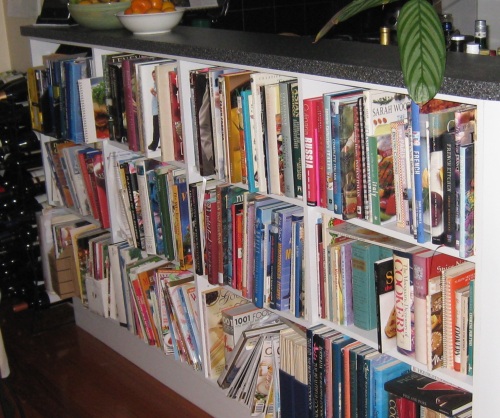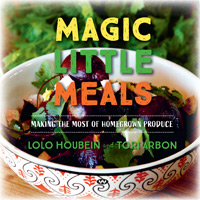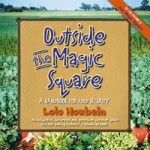 I’ve never thought about it before, but my cookbook shelves are a glimpse into the way I’ve lived my life. The oldest ones are recipe books for a beginner cook wanting to do it well: they include the CWA cookbook and Mastering the Art of French Cooking, plus Margaret Fulton and the Women’s Weekly Cookbooks. Recipe books from the 80s reflect my ‘earth mother’ phase, when I made everything from scratch. They also represent a long period of time when I was a vegetarian, mainly because I was (still am) opposed to factory farming. This phase led me to branch out into recipes from all over the world with recipes for Italian, Chinese and Asian cooking, and when The Spouse came into my life and we began to travel overseas, things became more adventurous so that now there are books of Russian, Spanish, Portuguese, Vietnamese and Middle Eastern cuisine. The recipes became more complex too, influenced in part by MasterChef, but also by the restaurant scene here in Melbourne. You can see this in some of the foodie books I’ve reviewed here on my blog, with pride of place going to my efforts to reproduce a recipe by Heston Blumenthal.
I’ve never thought about it before, but my cookbook shelves are a glimpse into the way I’ve lived my life. The oldest ones are recipe books for a beginner cook wanting to do it well: they include the CWA cookbook and Mastering the Art of French Cooking, plus Margaret Fulton and the Women’s Weekly Cookbooks. Recipe books from the 80s reflect my ‘earth mother’ phase, when I made everything from scratch. They also represent a long period of time when I was a vegetarian, mainly because I was (still am) opposed to factory farming. This phase led me to branch out into recipes from all over the world with recipes for Italian, Chinese and Asian cooking, and when The Spouse came into my life and we began to travel overseas, things became more adventurous so that now there are books of Russian, Spanish, Portuguese, Vietnamese and Middle Eastern cuisine. The recipes became more complex too, influenced in part by MasterChef, but also by the restaurant scene here in Melbourne. You can see this in some of the foodie books I’ve reviewed here on my blog, with pride of place going to my efforts to reproduce a recipe by Heston Blumenthal.
 At first glance, Magic Little Meals belongs back in my ‘1980s earth mother’ phase. It’s not a glossy ‘food-porn’ book. It’s only 200m square, and although it’s profusely illustrated, the stylist has concentrated on the food and the ingredients rather than the décor. But it’s actually a profoundly contemporary book because it addresses a concern that so many of us have…
At first glance, Magic Little Meals belongs back in my ‘1980s earth mother’ phase. It’s not a glossy ‘food-porn’ book. It’s only 200m square, and although it’s profusely illustrated, the stylist has concentrated on the food and the ingredients rather than the décor. But it’s actually a profoundly contemporary book because it addresses a concern that so many of us have…
We have had a terrible year in the kitchen garden. We harvested barely enough tomatoes to fill a pudding bowl, our beetroot failed altogether, and as I write there are two – just two – eggplants finally emerging from plants that had many flowers but otherwise had failed to fruit at all. Our only success has been the pumpkin vine. The reason for this debacle is that the weather has been profoundly affected by climate change, and we hadn’t changed our practice to accommodate it. And not one of our numerous gardening books has any advice, and the ABCTV’s Gardening Australia has been no help at all. If there is anything on their website about how to handle extreme weather situations, I can’t find it.
But Magic Little Meals is all about growing your own food for the table, and it is written with a keen sensitivity to the way the world is now. It’s the only book I’ve ever come across that has practical tips for protecting the vegies during those extreme heat waves.
Lolo, who as a child lived through the Dutch famine of 1994-45, knows the importance of food:
While war raged, I lost contact with my family after a children’s transport took me to an eastern province. Here, foster parents increased my weight by 50% in four months. Growing one’s own food was the rule there, one of many life lessons learned during that period.
But good land is the key. In Australia I grew my first fruit and vegetables. I worry about the speed at which the Australian environment is being logged, mined out and sold off to make the nation grow. With partner Burr Dodd I planned how to revegetate South Australia by 2050. The result was the movement known as Trees For Life.
I wrote about my gardening experiences for my grandchildren to prepare them for possible food shortages. One Magic Square: Grow your own food on one square metre and its companion Outside the Magic Square: A handbook for food security are still in print. [Click the links to go to the Wakefield Press website.] This present volume, written with Tori Arbon, is a response to readers’ requests. It completes the unintended trilogy. May these books continue to inspire people to recognise that good food comes from good soil and that widespread growing at home can perhaps save the planet.
As I took Amber for her walk today, I noticed yet again how new housing developments in our street have reduced the space for gardens. When I moved here in 1979, all of the houses built in the frugal fifties had a front and back garden, the front used for ornamentals, and the back for play space, the vegie patch and the washing line. But now? The two story townhouses built diagonally behind us have only a pocket-handkerchief front garden with a patch of lawn smaller than a bed sheet, and a strip of land at the back where they *sigh* have planning permission to plant bamboo. There are growing numbers of McMansions housing families of just four: these are built right to the edge of boundary fences, with barely enough room for a single tree. This is typical of the way styles of urban living now make people dependent on buying all their food, but the other result of urban expansion is that some of our best arable land is being swallowed up by outer-urban housing.
I remember my mother saying of England that she never again wanted to live in a country that couldn’t feed itself. Could Australia ever be reduced to relying on imports? Lolo Houbein asks, what if China, currently exporting to Australia, can’t feed its billions in the future?
There are things that we can do. Magic Little Meals asks for no more than one square metre of land, and has tips for growing food in pots on balconies too. Their best tip for apartment dwellers is to
ask neighbours whether you can all grow one or two different vegetables and do swaps. One climbing tomato could provide enough for 8 people; on cabbage could be quartered. As for one zucchini plant… you’ll find out! (p.3)
There are five parts to this book: after the introduction, each chapter in Part One depends on a freshly picked vegetable from your garden with growing notes provided for each vegetable. Part Two is about making food interesting with herbs and spices. Part Three, ‘Kitchen Mysteries Unwrapped’ is for novice cooks to learn the basics and the secrets of preserving a glut. Part Four is about growing and eating your own fruit: for us that’s just citrus trees and olives, but the advice applies just as well if you are buying fruit when it’s in season. (Cheap strawberries, the little ones that supermarkets don’t want) when quartered and dried are delicious with winter cereal!) Part Five, is about the health and community values of taking an holistic approach to the food you eat. It is this part that has a whole section called ‘Vegetables to Grow in Very Hot Summers’: it explains about the pollination problems we had and how some plants with exposed fruit like eggplant, tomato and capsicum ‘stand still’ through heat waves.
There are other really useful aspects to this book: one of the most important is that the recipes are for 1-2 persons. You can easily double them to make meals for four, but how often do you find that the recipe for four in the other cookbooks ends up with three serves being eaten by two people and the one-serve leftover in the fridge ends up being thrown out? This is terrible from a food waste point-of-view, but recipes don’t always halve very well, e.g. when it uses only one egg.
So, what are the recipes we’re going to try?
- Pumpkins (obviously). Ever heard of cooking pumpkin vine tips? No, nor had I. It turns out that there’s some pruning you’re supposed to do, and you can cook the tips with fennel and coriander, and finish them off with coconut oil, olive oil or pumpkin oil. (Ever heard of that? I hadn’t. Google tells me there are all sorts of claims for its health benefits. But it appears to be expensive: about $25 for 250ml.) There’s a recipe for unripe pumpkin soup too.
- Eggplants (obviously, unless the possum gets them). I’ve tried a couple of recipes for Baba Ganoush, and I’ll try this one too. All of them have the same ingredients, it’s all in the proportions. I yearn to make one as good as our friend Zeina does, but she doesn’t use a recipe!
- Speedy celery salad: our celery are newly planted right now, but it won’t be long before we have heaps. I like the addition of Moroccan spice mix to this recipe.
- Capsicums: we are still getting a few fingerlings from a heritage capsicum plant, and they tend to get wasted because we don’t use capsicums all that much. So the Hungarian Goulash Vegetarian might be just the thing, especially since it apparently tastes even better the next day. White beans substitute for the meat in the traditional carnivores recipe.
- Spicy Beetroot stems. Who knew? These can be steamed with garlic, onions, mustard seed and other spices. The recipe calls for a dollop of yoghurt but that’s no problem because I make my own. (Kitchen Warehouse sells a set-and-forget yoghurt maker that makes it ridiculously easy.)
- Finally, potatoes, when we have them next season: I’ll have a go at Boxty: it’s an Irish recipe, sort of like a cross between a pancake and a rosti.
Just one thing: the recipe for making your own ricotta cheese says you need unhomogenised milk. Not so. From 2 litres of ordinary homogenised milk from the supermarket, I use a little bit in whatever recipe calls for it, make yoghurt with about 2/3 of the rest of it, and then ricotta with whatever is left over. And you can use lemon juice instead of vinegar if you have lots of lemons. The recipe I use says that the only kind of milk you can’t use is long life (UHT) milk because it won’t curdle.
Authors: Lolo Houbein and Tori Arbon
Title: Magic Little Meals, Making the Most of Homegrown Produce
Publisher: Wakefield Press, Adelaide, SA, 2019
ISBN: 9781743055793
Review copy courtesy of Wakefield Press
Available from Wakefield Press and Fishpond: Magic Little Meals: Making the most of homegrown produce




Haha, Lisa, given we are a similar age, my recipe shelves are just like yours, with the Commonsense Cookery Book, Margaret Fulton, and others, and the 70s vegetarian and earth-mother books, moving into the 70s/80s travel inspired book. I have downsized a few in recent years, but only a very few because they contain MY history and even the ones I never use now take me immediately back to where and/or why I bought them. My first travel inspired book is still a favourite Italian one.
But I think you’ve hit on something – I think there’s a real return to that 70s earth-mother phase now. I see it a lot in my daughter’s friends in particular. It probably has different ethical drivers but the heart is similar.
Oh and I loved your comment about how often 3/4 of recipes for 4 being used by two people leaving 1/4 portion behind. Fortunately here, I often have that 1/4 while Mr Gums has pizza or a (special gourmet) pie that I can’t have but he likes. Leftovers like that are hardly every wasted as a result of my food intolerances!!
LikeLike
By: whisperinggums on April 18, 2019
at 5:09 pm
Hi Sue, you know, I read something today (ABC Online? The Guardian?) and it was about collecting, and the reasons for it. It was mainly about people who seek out stuff for their collections (e.g. old sewing machines and magazines), not like this where the collection has grown naturally and also where it is useful, but among the reasons they cited was people feeling nostalgia for the past or wanting to leave something of themselves for the future. I think there is an element of that when we see that these books are ‘our history’, though even then, there are still recipes that I use from among the oldest books.
I do hope you are right about a resurgence of that 70s era!
LikeLike
By: Lisa Hill on April 18, 2019
at 7:05 pm
Oh yes, I agree with all that about collecting – after all, I did work in a cultural collecting institutions (though I believe the description now is “memory institution” Honestly can’t keep up!)
Anyhow, like you I think it is more about my own history than about leaving something of myself for the future. I have no illusions that others will love my books! Hmm, BUT I do love objects from past family members that THEY left behind – my grandmother, mother in law, aunt, etc. Every time I use a cup or a dish or a vintage spoon or wear an old necklace, I remember them. It’s really special.
BTW I do still use some recipes from old books too – I didn’t mean to imply I don’t. Some of course are no longer used, given different styles of cooking (not to mention my food intolerances which have changed my life.)
I’ll see if I can find that article.
LikeLike
By: whisperinggums on April 18, 2019
at 7:17 pm
*chuckle*
LikeLiked by 1 person
By: Lisa Hill on April 18, 2019
at 7:40 pm
Well this is a bit different to your usual Lisa :) and very enjoyable too. It’s reminded me I must go and water the basil on my balcony. I also have cookbooks dating back decades, but not so many because I’ve moved so often I’ve had to streamline the collection. I have some regrets about that now. Anyway, I like your review, this book sounds good & I hope you get more luck with your gardening in future.
LikeLike
By: maamej on April 18, 2019
at 8:16 pm
Is there anything more beautiful to eat than fresh tomato and basil on crusty bread? I hope yours is thriving:)
LikeLike
By: Lisa Hill on April 18, 2019
at 8:56 pm
It’s a new plant, so yes – happy on my sunny balcony.
LikeLike
By: maamej on April 18, 2019
at 8:59 pm
Perfect:)
LikeLiked by 1 person
By: Lisa Hill on April 18, 2019
at 9:04 pm
I have a cookbook collection too, and lots of vego recipes from papers and magazines but no, I never (what never? well, hardly ever) cook, but have lived through those same phases second-hand as the very capable Milly cooked for me. We were trying to establish over dinner a couple of nights ago where it all started – somewhere in the mists of time before Pritikin in the early 80s.
Milly’s going to need this book. As of yesterday she’s gone and retired and will be relying to a substantial extent on her cottage garden.
LikeLike
By: wadholloway on April 19, 2019
at 8:18 am
Yay for Milly! I hope she has a wonderful retirement. I have a suggestion for her birthday present this year – a big roll of shadecloth to protect the plants during heat waves!
LikeLike
By: Lisa Hill on April 19, 2019
at 11:39 am
I recently got rid of most of my cookbooks. The 80s Earth mother ones, the ones from places we travelled to. I had just too many. I still have some nice ethnic ones though.
LikeLike
By: Travellin' Penguin (Pam) on April 19, 2019
at 3:37 pm
Do you miss them?
LikeLike
By: Lisa Hill on April 19, 2019
at 4:04 pm
[…] Magic Little Meals, Making the Most of Homegrown Produce, by Lolo Houbein and Tori Arbon […]
LikeLike
By: Nonfiction November – My Year in Nonfiction | ANZ LitLovers LitBlog on November 1, 2019
at 7:12 pm